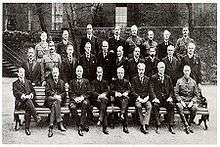Imperial War Cabinet


The Imperial War Cabinet was the British Empire's wartime coordinating body. The Imperial War Conferences of 1917 and 1918 were a series of meetings held concurrent with the Imperial War Cabinet to co-ordinate governance of the British Empire during the war and prepare for the post-war situation.
First World War Imperial War Cabinet
The Imperial War Cabinet was created by British Prime Minister David Lloyd George in the spring of 1917 as a means of co-ordinating the British Empire's military policy during the First World War. Its creation was the result of a recognition by Lloyd George that the increased contribution by the dominions to the war effort necessitated increased consultation with dominion governments on the conduct of the war.
Participants
The body met through 1917 and 1918
Imperial War Conferences
| Imperial War Conferences | |
|---|---|
| Dates |
21 March 1917 – 27 April 1917 12 June 1918 – 26 July 1918 |
| Cities |
|
| Chair |
David Lloyd George (Prime Minister) |
| Follows | 1911 Imperial Conference |
| Precedes | 1921 Imperial Conference |
| Key points | |
|
Imperial constitutional arrangements, Imperial Federation, international relations and treaties | |
The Imperial War Cabinet existed concurrently with Imperial Conferences (or "Imperial War Conferences") which were held from 21 March to 27 April 1917 and from 12 June to 26 July 1918.
In April 1917, the conference passed Resolution IX which resolved a conference was to be held after the war in order to rearrange Imperial constitutional arrangements "based upon a full recognition of the Dominions as autonomous nations of an Imperial Commonwealth", and should give the Dominions and India "a right... to an adequate voice in foreign policy and in foreign relations." This was the first instance in which the term Commonwealth was used officially.[1] The Imperial War Conference acknowledged the importance of the whole empire in defence policy by admitting India, not yet self-governing, to future imperial conferences.
In 1917 the Imperial War Conference also passed a resolution regarding a future special Imperial Conference to readjust the relations of the component parts of the Empire. That readjustment should be based upon the full recognition of the dominions as autonomous nations of an Imperial Commonwealth, with an "adequate voice" in foreign policy.
Second World War
Australian prime ministers Robert Menzies and John Curtin campaigned for the creation of an Imperial War Cabinet during the Second World War that would include representatives of all four dominions. British prime minister Winston Churchill was unenthusiastic as he felt the concept was unwieldy and since he was tepid towards the idea of sharing authority with the dominions.
Australia was unable to secure the support of the other three dominions: Canada, South Africa and New Zealand (the Irish Free State was neutral during war).[2] Canadian prime minister William Lyon Mackenzie King was concerned that the idea would be a step towards Imperial Federation, which he opposed, New Zealand's government was satisfied with Churchill's conduct of the war and saw no need for change while South African prime minister Jan Smuts was already a Churchill confidante and similarly saw no need to change the way the war was run. It was also felt impractical for dominion prime ministers to spend extended periods in London instead of in their own capitals and that dominion ministers appointed to sit in an Imperial Cabinet would lack the authority to make decisions.
Instead of creating a separate Imperial War Cabinet, Churchill invited Smuts and Menzies to sit in and join the deliberations of Britain's War Cabinet whenever the leaders were in London. (These meetings of the British War Cabinet have sometimes been referred to as an Imperial War Cabinet.)
Stanley Bruce, Australia's High Commissioner to London, was delegated by his government sit in on meetings of Churchill's War Cabinet. However, Churchill found Bruce's advice to be contrary to his own priorities and, as a result, Bruce found he was often not told when meetings were being held.
The 1944 Commonwealth Prime Ministers' Conference was called to obtain Commonwealth agreement to the Moscow Declaration of war aims and to co-ordinate Commonwealth efforts in the concluding years of the war and prepare for peacetime reconstruction and restructuring.
See also
References
- ↑ "Commonwealth". The Canadian Encyclopedia. Historica-Dominica. Retrieved 28 April 2013.
- ↑ http://books.google.ca/books?id=86bYnA1hRX4C&pg=PA110&lpg=PA110&dq=%22imperial+war+cabinet%22+menzies&source=bl&ots=lTPlx8jFYl&sig=gWLYdeShvteOf6rUdac41zs87DA&hl=en&sa=X&ei=E1t_UbLBBuaDywGfk4HYDA&ved=0CBsQ6AEwBw